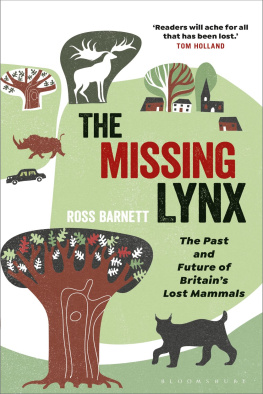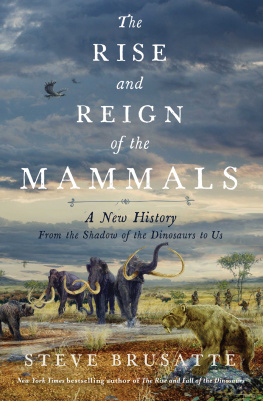A wonderful and haunting book: so rich in detail that the mammals of Britainspast seem brought to life again, and yet so unsparing in its portrayal of the brute facts of extinction that readers will ache for all that has been lost.
Tom Holland, author and historian
As elegies go, The Missing Lynx is an awful lot of fun Barnetts writing is clear and unobtrusively witty And the book is full of cheery, Terry Practchett-esque footnotes.
The Times
Rewilding is certainly romantic but is it practical or even desirable? It allneeds thinking through, and Barnett, who makes a compelling case in favour of the idea, can help.
BBC Wildlife
Fresh and assured An often moving tribute to lost marvels.
Nature
The story of Britains Ice Age bestiary, told with bittersweet humour, and a clarion call to us all to step up and fi ght future extinctions.
Tori Herridge
Barnetts writing is clear and accessible, and often amusing.
BBC Countryfile
With his fast-paced and amusing tales of some of the most awe-inspiring species lost within geologically recent times, The Missing Lynx brings Britains Ice Age back to life.
Professor Beth Shapiro, author of How to Clone a Mammoth
A fascinating account of the large herbivores and predators that have disappeared from Britain since humans reached our islands. This should be essential reading for those who advocate rewilding.
Professor Richard Fortey, palaeontologist and author The fi rst chapter of @DeepFriedDNAs new The Missing Lynx is one of the most powerful, emotionally arresting openings Ive read in a book in a long, long time.
The Well-read Naturalist
Read this book by palaeontologist Ross Barnett its quirky, informative,superbly well-written and crammed with an avalanche of facts (and utterly fascinating digressions) which bring a tantalising world of recently vanished ice age creatures to life. And did I mention the footnotes? This book has THE most entertaining footnotes of any book Ive ever read!
Ian Roberts, author
It is a fascinating publication by a specialist in analysing and interpreting ancient DNA. Packed full of scientifi c data and detail of fossil discoveries it is written with great humour, even cunningly weaving in snatches from literature and film.
Professor Keith Somerville, talkinghumanities
A NOTE ON THE AUTHOR
Ross Barnett is a palaeontologist with a PhD in Zoology from the University of Oxford. He specialises in seeking, analysing and interpreting ancient DNA, but his area of expertise is the genetics and phylogeny of cats, especially the extinct sabretooths. Barnetts research has led to many remarkable fi ndings in recent years and has involved investigating escaped lynx in Edwardian Devon, rubbishing claims that the yeti is an ice-age polarbear and seeking the ancestral home of the enigmatic Orkney vole. In 2018, he received the Palaeontological Associations Gertrude Elles Award for Public Engagement. Barnett currently lives in the Highlands of Scotland with his wife and two daughters.
@DeepFriedDNA
Dedicated to my hopes for the future:
Alice Iona and Naomi Catriona

Contents
Thanks primarily to Jim Martin and Jenny Campbell at Bloomsbury for everything they have done.
Thanks also to Myriam Birch for her word-wrangling.
Many people have helped me on my journey, and a proper list of those I am indebted to would be longer than the book itself. For help with the research specifically for this book, I spoke to many experts in many fields: Ian Barnes, Jim Crumley, Love Daln, Ceiridwen Edwards, David Hetherington, Andrew Kitchener, Greger Larson, Adrian Lister, Joyce Lundberg, Pavel Nikolskiy, Hannah ORegan, Alison Parfitt, Patrcia Penerov, Malgorzata Pilot, Jelle Reumer, Ricardo Rodrgues-Varela, Beth Shapiro, Tony Stuart, Naomi Sykes, Becky Wragg Sykes, Cris Valdiosera and Lars Werdelin gave me invaluable insight into many species.
All maps used in this book are modified from originals from d-maps (www.d-maps.com).
I would like to thank my writing and blogging buddies Jan Freedman and Rena Maguire for copious kind words and encouragements. Id also like to thank Anna Barker and Pat Barker for advice and motivation. Many friends past and present helped me on my way: Sinclair Swan, Iain Innes, Blair Duncan, Christopher Gell, Simon Lloyd, Simon Sylvester, Jordan Dunn, Simon Baker, Billy Kinnear and a number of others whose constant criticisms of my many personal faults prepared me for the rigours of publication.
Thanks to my family: my sisters Jaqueline, Adriana, Lexi; my parents Dave and Raquel. To my late, beloved grandparents, Nan and George, who did so much to make me who I am. Thanks to my mother-in-law, Elizabeth Howe, for support and babysitting.
Thank you to Alice and Naomi for showing me new worlds every day.
Bittersweet gratitude for my mothers memory, for giving me my first insight into extinction.
Thanks is too small a word to encompass my appreciation of my wife, Bridie, who has been with me through thick and thin for two decades.
The crust of our earth is a great cemetery, where the rocks are tombstones on which the buried dead have written their own epitaphs.
Louis Agassiz
We are living through the sixth mass extinction.
Stretch your arms out either side of your body. Go on. Nobodys watching. Now, imagine that the distance from your left fingertip to your right fingertip is the history of all complex life on earth, starting with the first multicellular animal about 580 million years ago.
Using this bodily chronometer, the first mass extinction takes place at your left elbow. Here, at the end of the Ordovician period 444 million years ago, nearly nine-tenths of all marine species die out. The disappearance of many forms of graptolite, preserved as tiny comb-shaped fossils found worldwide, give testimony in the rocks. Life continues.
The second mass extinction takes place at your left shoulder. Here, at the end of the Devonian period 376 million years ago, three-quarters of all species disappear. The coiled ammonite and the segmented trilobite barely scrape through. Life continues.
The third mass extinction occurs at your right shoulder: this was the big one around 250 million years ago, known as the Great Dying. The end of the Permian period nearly sees the extinction of all life on earth. Only four out of every hundred species survive. The few trilobite groups that had lived through the Devonian extinction curl up and disappear completely. No one really understands what happened to cause it, but a massive increase in greenhouse gases, especially methane, created by new forms of bacteria, is one suspect. Life continues.
The fourth mass extinction takes place at your right elbow. Here, at the junction between the Triassic and Jurassic periods 200 million years ago, only half of all species disappear. Conodonts, diverse members of a lamprey-like family of boneless fish, disappear completely, leaving nothing but their enigmatic teeth behind. Life continues.
The fifth mass extinction, at your right wrist, is the end of the dinosaurs reign 66 million years ago. This transition between the Cretaceous and Palaeogene periods witnesses the demise of the dinosaurs, flying pterosaurs and marine ichthyosaurs and plesiosaurs. The impact of an asteroid at the Chicxulub crater site in Mexico is strongly implicated in the process. Death from space. Millions of tonnes of vaporised bedrock entering the atmosphere and making the sun as black as sackcloth. Global cooling, acid rain, mass extinction. Life continues.








